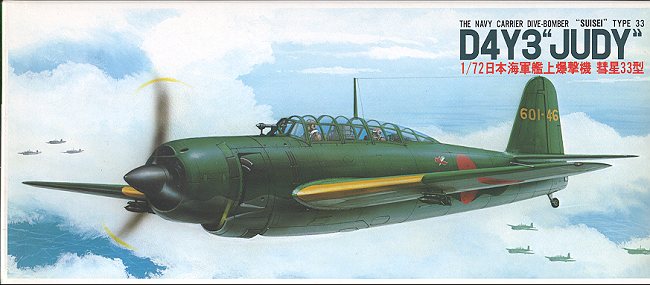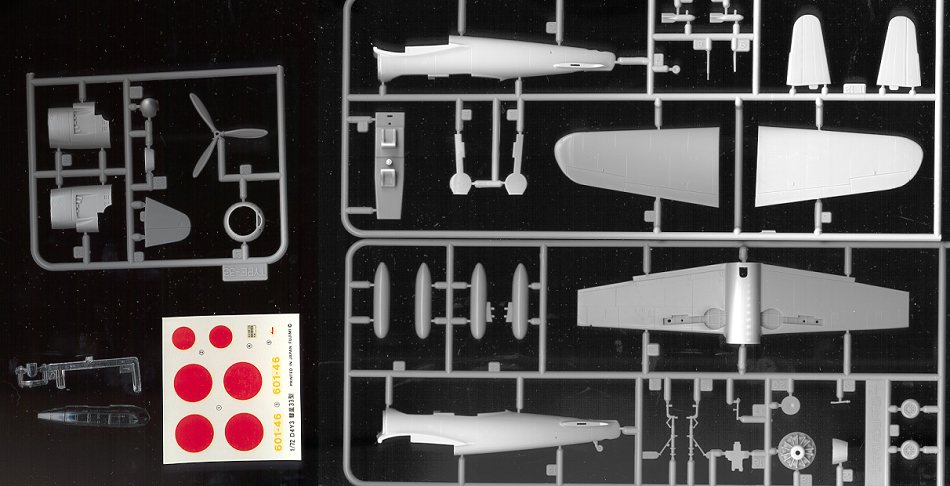
|
KIT: |
Fujimi 1/72 D4Y3 Suisei "Judy" |
|
KIT # |
7AC6 |
|
PRICE: |
@$15.00 |
|
DECALS: |
One aircraft |
|
REVIEW & |
|
|
NOTES: |
Currently unavailable (July 2000) |

|
HISTORY |
The esthetically pleasing D4Y Suisei (Comet) was designed as a replacement for the aged D3A 'Val' dive bomber. The original design was powered by a license built DB.601 liquid cooled engine and was loosely based on the He-118v4 which the Japanese has acquired the right to build. The introduction of the Suisei into the fleet was slow and not fully implemented until mid-war, by which time most of the experienced air crews were gone.
Problems with maintaining the Atsuta (DB.601) engine were a major cause of the unreliability of the early 'Judys'. Naval officials had been strongly advocating using a more reliable radial engine to replace the trouble-plagued in-line one. Despite the difficulties of attaching a wide radial engine to the slim fuselage of the Suisei, a prototype was successfully flown in May 1944 using a 1,500 hp Mitsubishi Kinsei 62 14 cylinder radial engine. The performance of the radial version was virtually identical to that of the in-line version, despite the larger frontal area of the former. The only down side was some loss of visibility during ground operations thanks to the larger engine.
Production of the D4Y3 and D4Y4 commenced and by the war's end, a nearly equal number of both in-line and radial versions had been produced. The D4Y4 was a dedicated suicide bomber version of the D4Y3. The radio operator and gunner's positions were eliminated (though the plane was externally nearly identical to the D4Y3) and the aircraft fitted to carry a single 800kg bomb semi-recessed in the lower fuselage. Nearly 300 of this version were built. The D4Y3 participated in the last offensive actions of the war, many of them being expended as suicide aircraft alongside the D4Y4.
|
THE KIT |

Fujimi kits have long had a mixed reputation. They have either been a joy or a pain to build. Why this is is unknown as they have always been fairly well detailed and of interesting subjects. This kit is typical of the Fujimi policy of doing multiple versions from a basic mold. I'm not positive, but I would be willing to bet that this 'multiple versions' trend started with Fujimi back in the 1980s.
The kit is in the typical medium grey plastic. It has fine engraved detailing, no flash, no ejector pin marks in visible locations, and no sink marks. Cockpit detail is adequate but not spectacular as there is no sidewall detail and just minimum parts for the inside. The options are for drop tanks and/or bombs on the wings and for building the model gear up. No display stand is provided for this last option. All the bits for the radial engined variant are on a separate sprue. There is some detail in the wheel wells and the landing gear are well done and scale. The transparency is very crisply molded and thin.
The instruction sheet contains 6 construction steps, noting any needed colors in each step. The construction steps are very clear and concise. Probably the biggest complaint I have about most Fujimi kits is that they generally offer no choice for markings. This is true of this kit as well. I'll be the first to admit that late war Japanese Naval aircraft were pretty non-descript, being painted dark green over grey and having only tail codes to differentiate between them, but it couldn't be that tough to add a few more codes to the decal sheet. As it is, you get an aircraft of the 601st Kokutai showing a single ship kill mark on the fuselage.
Overall it is a relatively simple build. There are, to my knowledge, no aftermarket parts of any kind for this kit so you are on your own when it comes to extra detailing. Having built the in-line engined version, I can recommend this kit to all skill levels.
|
REFERENCES |
Japanese Aircraft of the Pacific War by Rene J Francillon, Putnam, 1979
Review copy courtesy of me and my wallet!
If you would like your product reviewed fairly and quickly by a site that has over 1,000 visits a day, please contact me or see other details in the Note to Contributors.